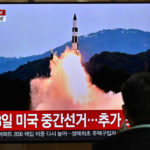
(SEOUL, South Korea) — North Korea test-fired three missiles on Thursday, a day after launching its most-ever tests in a single day.
One long-range and two short-range ballistic missiles were tested, South Korean officials said. Tokyo initially said the longer-range ballistic missile had flown over Japan, warning residents of Miyagi, Yamagata and Niigata prefectures to take shelter. But Japan’s Defense Ministry later said the missile did not fly over Japan.
Authorities said they were still analyzing the details. Analysts suggested that the missile, which flew 472 miles and reached a height of 1,200 miles, was presumably an intercontinental ballistic missile that failed.
“We can sense North Korea’s anxiety from recent launches. In fact, these missile launches are a huge burden for their military, especially when North Korea is so economically cut off,” Park Won-gon, professor of North Korean Studies at Ewha Womans University, told ABC News.
The provocations are a typical brinkmanship tactic to either bring the U.S. and South Korea into nuclear talks or a prelude to justifying an imminent seventh nuclear underground test.
“It’s possible to assume that North Korea will decorate the grand finale of its tactic with the seventh nuclear test, and then suggest a deal,” said Park.
The two Koreas test-fired missiles one after another throughout Wednesday in a series of tit-for-tat moves. North Korea fired a total of 23 missiles that were a combination of ballistic and surface-to-air weapons, and 100 artillery shells from various locations toward the east and west. In a retaliatory move, South Korea quickly responded in between by launching its own air-to-surface missiles into a similar area above the NLL, launched by two F-15K and KF-16 jet fighters.
Pyongyang claimed the missile tests are “self-defensive” in nature. Officials called for the U.S. and South Korea to stop their annual joint military drills, which they said were “aggressive and provocative.”
“They are going on a full-scale sprint. Not only are there a variety of missiles, but also a great number of them,” Park added.
Dr. Yang Uk, of Seoul-based Asan Institute, told ABC News that the missile launches are a way to show off Pyongyang’s tactical nuclear capabilities.
“It’s an adamant statement that they will respond with all forces by fully mobilizing all the means they have,” Yang explained.
South Korea’s air force announced Wednesday shortly after North Korea’s ballistic missile provocation, that the joint air drill between the U.S. will be extended. It was originally planned for five days from Oct. 31 to Nov. 4.
Copyright © 2022, ABC Audio. All rights reserved.
